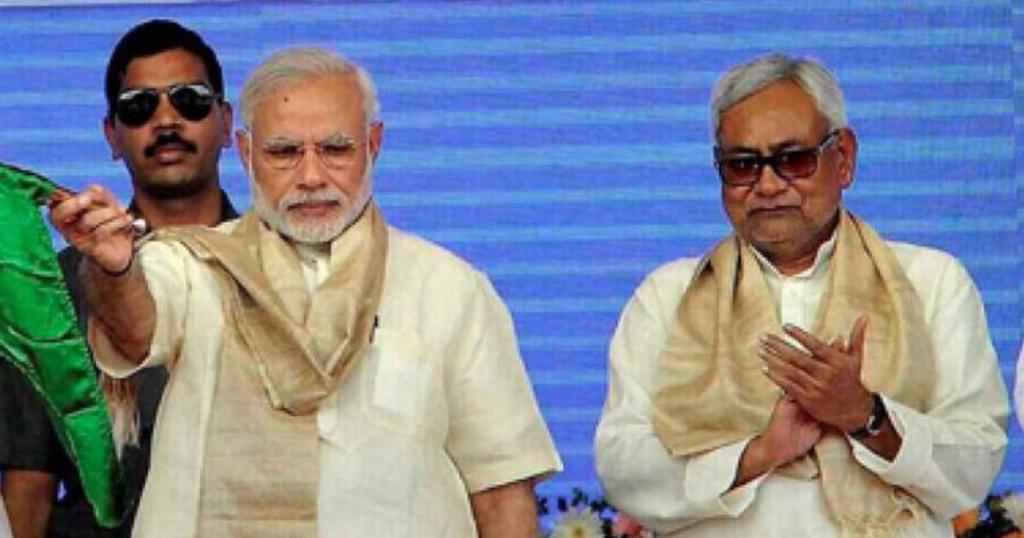Bihar has always been an epicenter of rugged politics in India. With alliances forming and dissolving overnight, Bihar politics has been a subject of curiosity for many political analysts. The 2019 general elections also saw this curiosity being transformed into opinions and analysis of several political pundits. Like all the opinions, some stood the test of time while some failed to resonate with the public, nonetheless a single aspect on which consensus can be reached on is surely JD(U) rise in Bihar riding on the back of which many are calling tsuNAMO2.0.
The 2014 general elections, which saw Bihar going into a trilateral fight among BJP-JD(U)-RJD, was surely defined by a surge of pro-Modi sentiment in the electorate. With BJP led NDA winning on 31 out of the total 40 parliamentary constituencies in the state. Nitish Kumar’s JD(U) which walked out of the 17-year-old alliance just about a year from the 2014 polls citing ‘basic principles’ just managed to win on 2 seats as compared to 20 in the 2009 general elections.
The 2014 general elections were surely a wakeup call for Nitish Kumar’s JD(U) which was looking at the Bihar state assembly elections in 2015 just one year down the road from the 2014 polls. After JD(U)’s plan to fight independently failed to materialize, JD(U) was surely desperate to reach out to other parties in order to provide credible resistance to the BJP. Naturally, RJ(D) emerged as the best bet for JD(U). Facing an existential crisis of its own, RJD accepted arch rivals JD(U) with open arms into an alliance for the 2015 assembly elections. Propelled by the caste calculations and fringe support from Congress, the RJD-JD(U) Mahagathbandhan was successful in crossing the majority mark.
The alliance in Bihar captured a total of 178 assembly constituencies, with RJD appearing as the largest party in the alliance with a total of 80 MLAs followed by JD(U) (71) and the Congress (27). However what is interesting to note that despite getting a higher number of seats, RJD conceded the CM’s post to Nitish Kumar. However, cracks in the alliance were visible from day one over power-sharing issues, for which, not much late in 2017, Nitish Kumar dumped the alliance with RJD and came back to the NDA fold. Calculations regarding the 2019 general elections evidently drove JD(U)s decision to split with the RJ(D), as the final numbers show that the JD(U) benefitted immensely from the pro-Modi wave in the state. For 2019 general elections, Nitish drove a hard bargain and BJP conceded more seats to it than was necessary. Riding on PM Modi’s popularity, even the dead-weights of JD(U) were elected and against all expectations, the party got 17 MPs.
Following the trend JD(U) seems to be again on the path of ditching the NDA as all its political ambitions stand fulfilled as evident by Nitish Kumar’s recent theatrics and misplaced confidence. Bihar CM has so far refused to reprimand Prashant Kishor vice president of the JD(U) for working with NDA nemesis Mamata Banerjee and now JD(U) has proclaimed that it will be contesting elections in upcoming state assembly polls in Delhi, Haryana, Jharkhand and Jammu and Kashmir independent of the NDA.
Read more: Why BJP must dump Nitish Kumar immediately
Looking at the track record, it is safe to say that by jumping alliances in a snap Nitish Kumar has surely improved JD(U)’s political standing. On the losing end are surely the BJP and RJD which had to accommodate JD(U) and even concede significant political ground for the sake of the alliance. Alliance with the BJP and RJD has partly helped Nitish Kumar to consolidate the core party votes in the state. RJD has surely felt the pinch of Nitish Kumar’s actions, with the party losing almost all of its relevance in the Bihar political scene. BJP though it enjoys power in both Centre and in the state of Bihar surely has some lessons to learn from the JD(U)’s volatile commitment history.
